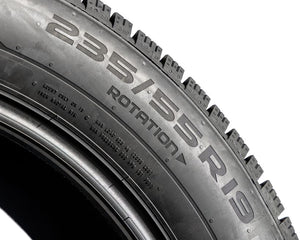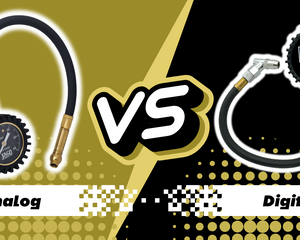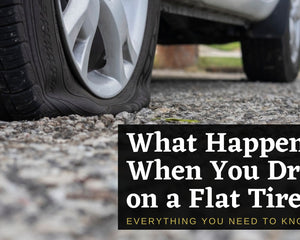If you've ever been driving along and suddenly noticed your tire pressure light come on, you know how alarming it can be. But what does it mean when your tire pressure light comes on, and what should you do about it? In this post, we'll cover everything you need to know about your tire pressure light, including the reasons why it might come on, how to reset it, and what to do if you see it while driving.

What is a tire pressure monitoring system (TPMS)?
First, let's talk about how your tire pressure monitoring system (TPMS) works. Most modern vehicles are equipped with a TPMS, which is a system that monitors the air pressure in your tires and alerts you if it falls below a certain level. The TPMS uses sensors located in each tire to measure the pressure and send a signal to the dashboard display or a warning light if the pressure falls below the recommended level. This is usually around 25% below the recommended tire pressure, which is usually around 30-35 PSI for passenger vehicles.
Reasons why your tire pressure light might come on
So, why might your tire pressure light come on? There are a few common reasons:
-
Low tire pressure: If one or more of your tires is underinflated, the TPMS light will come on to alert you. Underinflated tires can cause a variety of problems, including poor handling, reduced fuel efficiency, and increased tire wear. It's important to check your tire pressure regularly and inflate your tires to the recommended level to avoid these issues.
-
TPMS malfunction: If the TPMS itself is malfunctioning, the light may come on even if your tire pressure is normal. If you see the tire pressure light and your tires seem properly inflated, it's a good idea to have the TPMS checked by a mechanic.
-
Cold weather: The cold weather can cause your tire pressure to drop, which can trigger the TPMS light. This is because the air inside your tires contracts as the temperature drops, which can cause the pressure to fall below the recommended level. If you see the tire pressure light come on in cold weather, it's a good idea to check your tire pressure and inflate your tires if needed.
-
New tires: If you've recently had new tires installed on your vehicle, the TPMS light may come on as the system adjusts to the new tires. This is usually temporary and the light should go off after a short period of time. If the light doesn't go off, it's a good idea to have the TPMS checked by a mechanic.

What to do if you see the tire pressure light while driving
Now that we've covered some of the reasons why your tire pressure light might come on, let's talk about what you should do if you see it while driving. First and foremost, it's important to remember that a tire pressure light is a warning, not a command. You don't need to pull over immediately if you see it come on, but you should take action as soon as possible. If you're on the highway or in heavy traffic, it's generally safe to drive for a short distance (a few miles at most) to find a safe place to pull over and check your tires.
Once you've found a safe place to pull over, the first thing you should do is check your tire pressure. You can do this using a tire pressure gauge or by looking at the tire sidewall (more on this later). If your tires are underinflated, inflate them to the recommended level. If your tires are properly inflated and the TPMS light is still on, it's a good idea to have the system checked by a mechanic.
How to reset a tire pressure light
Now, let's talk about how to reset a tire pressure light. If you've checked your tire pressure and inflated your tires as needed, you may need to reset the TPMS light to turn it off. The process for resetting the TPMS light varies depending on your vehicle, so it's a good idea to consult your owner's manual for specific instructions. Here are some general steps you can follow:
-
Locate the TPMS reset button or tool. This is usually located under the dashboard or in the glove compartment.
-
Turn the ignition key to the "on" position.
-
Press and hold the TPMS reset button or follow the instructions for using the TPMS reset tool.
-
Release the button or follow the instructions for the reset tool.
-
Turn the ignition key to the "off" position.
-
Start the vehicle and check the TPMS light. If it's still on, consult your owner's manual or a mechanic for further assistance.
It's important to note that resetting the TPMS light will not fix any underlying issues with the system or your tires. If the light comes on again after resetting it, you'll need to address the root cause of the issue.

Effects of altitude on tire pressure sensors
One question that often comes up when it comes to tire pressure is whether car tire pressure sensors are affected by altitude. The short answer is yes, tire pressure can be affected by altitude. At higher altitudes, the air is thinner, which can cause the air pressure in your tires to drop. This is especially important to consider if you're driving in a mountainous area or at high altitudes. It's a good idea to check your tire pressure more frequently when driving at high altitudes and inflate your tires to the recommended level if necessary.
How long can you drive with low tire pressure?
Another common question is how long you can drive for with low tire pressure and how far you can drive with a tire pressure light on. As we mentioned earlier, a tire pressure light is a warning, not a command, so you don't need to pull over immediately if you see it come on. However, driving on underinflated tires can be dangerous and can cause a variety of problems, including poor handling, reduced fuel efficiency, and increased tire wear. It's generally a good idea to pull over and check your tire pressure as soon as possible if you see the tire pressure light come on. If you can't pull over right away, try to find a safe place to do so as soon as possible.
Another question that often comes up is why the tire pressure light might go on even if the tire pressure is fine. As we mentioned earlier, the tire pressure light may come on if the TPMS itself is malfunctioning or if you've recently installed new tires. If you see the tire pressure light and your tires seem properly inflated, it's a good idea to have the TPMS checked by a mechanic.

Frequently asked questions about tire pressure lights
Now, let's talk about some other common questions related to tire pressure.
At what PSI will the low tire pressure signal come on?
As we mentioned earlier, the low tire pressure signal usually comes on when the pressure falls below 25% of the recommended level, which is usually around 30-35 PSI for passenger vehicles.
Could my tire pressure warning light go on if my tire is overfilled?
It's possible that the tire pressure warning light could come on if your tires are overfilled, but it's less common. Overinflated tires can cause a variety of problems, including poor handling and increased tire wear. It's important to inflate your tires to the recommended level to avoid these issues.
Why is my tire pressure light on after filling tires?
If you've recently filled your tires and the tire pressure light is still on, it's possible that the TPMS sensors haven't had time to adjust to the new pressure level. Give it a few minutes and see if the light goes off. If the light is still on after a few minutes, it's a good idea to have the TPMS checked by a mechanic to ensure it's functioning properly.
Why is TPMS light on soon after dealer fixes the tire pressure?
If you've recently had your tire pressure checked or adjusted at a dealer or mechanic, and the TPMS light comes on soon after, it's possible that the sensors haven't had time to adjust to the new pressure level. Give it a few minutes and see if the light goes off. If the light is still on after a few minutes, it's a good idea to have the TPMS checked by a mechanic to ensure it's functioning properly.
Will overinflated tires cause the TPMS light to come on?
It's possible that the TPMS light could come on if your tires are overinflated, but it's less common. Overinflated tires can cause a variety of problems, including poor handling and increased tire wear. It's important to inflate your tires to the recommended level to avoid these issues.
Why does the tire pressure light come on in the cold?
As we mentioned earlier, the cold weather can cause your tire pressure to drop, which can trigger the TPMS light. This is because the air inside your tires contracts as the temperature drops, which can cause the pressure to fall below the recommended level. If you see the tire pressure light come on in cold weather, it's a good idea to check your tire pressure and inflate your tires if needed.
Why did my TPMS light come on after new tires?
If you've recently had new tires installed on your vehicle, the TPMS light may come on as the system adjusts to the new tires. This is usually temporary and the light should go off after a short period of time. If the light doesn't go off, it's a good idea to have the TPMS checked by a mechanic.
Does tire pressure light stay on with a spare?
If you're using a spare tire and the tire pressure light is on, it's possible that the spare tire is underinflated. It's important to check the pressure of the spare tire and inflate it to the recommended level to avoid any issues.
Can I ignore the tire pressure light warning?
Ignoring a low tire pressure warning light can be dangerous and can cause a variety of problems, including poor handling, reduced fuel efficiency, and increased tire wear. It's important to take action as soon as possible if you see the tire pressure light come on. If you're unable to pull over and check your tire pressure right away, try to find a safe place to do so as soon as possible.
In addition to these issues, driving on underinflated tires can also increase your risk of a tire blowout, which can be extremely dangerous. It's important to check your tire pressure regularly and inflate your tires to the recommended level to avoid these issues.
Can low tire pressure cause my ABS light to turn on?
One final question that often comes up is whether low tire pressure can cause an ABS light to come on. While low tire pressure can cause a variety of problems, it generally will not cause the ABS light to come on. If you see the ABS light come on and your tire pressure seems normal, it's a good idea to have the ABS system checked by a mechanic.
Final Thoughts
In conclusion, it's important to pay attention to your tire pressure light and take action as soon as possible if you see it come on. Proper tire pressure is crucial for the safety, performance, and lifespan of your tires, so it's important to check your tire pressure regularly and inflate your tires to the recommended level. If you're unsure about how to check your tire pressure or reset the TPMS light, consult your owner's manual or a mechanic for assistance. By taking care of your tires and monitoring their pressure, you can help ensure that your vehicle is running safely and efficiently.
Remember, preparation is the key to success! Ensure you're always ready with the right equipment. A reliable tire pressure gauge from our collection is essential to maintain the perfect tire pressure balance, while our handy tire inflators will keep your tires at the optimal PSI as recommended by manufacturers. Be in control of your journey, every step of the way!





